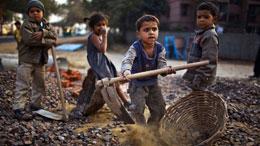Canadians want laws to ban child labour goods

For the last three years, Bithi has worked with thousands of Bangladeshi children piecing together designer jeans destined for stores in Canada and other high-income countries.
“The first day I felt bad, I thought it wasn’t good. I was too small,” Bithi remembers. But that was three years ago, when she was 12. Now, it’s routine.
Every day, Bithi helps create a minimum of 480 pairs of pants, for just over $1 USD a day.
“That’s 60 pockets an hour,” the 15-year-old explains. Bithi works in a cramped second-story room with 20 other Bangladeshi women, under fluorescent lights. The practice of sub-contracting jobs from larger garment factories allows government policies about
child labour to go unheeded here.
Although Bithi doesn’t complain, she can’t deny her longing to go to school. At one point, Bithi and her older sister Doli had dreamed of being doctors. But both girls have since put their dreams aside. There is no time for school when you’re fighting to survive.
There is but one story that is being used in a new report that says Canadians could be unwittingly purchasing billions in dollars of goods made by child labourers in other parts of the world.
World Vision’s "Canada's child & forced labour problem" report outlines the high risk of child and forced labour in common Canadian household products, the overwhelming Canadian consumer demand for legislative action and other realistic solutions required to address this Canadian issue.
"After visiting children around the world, I can say with conviction that child labour is also a Canadian problem. Canada imports products we use every day that have a high risk of child labour attached to them. There are at least 1,200 Canadian companies importing up to $34-billion in goods that may have been made by child or forced labourers overseas," said Michael Messenger, President, World Vision Canada
"Consumers, companies and governments should all play a part in addressing Canadian links to child labour. While we put pressure on other governments to eliminate child labour from their own countries, we put little pressure on the Canadian companies that source from these places to try to ensure kids aren't part of their supply chains. And that creates a gap where children are still working. We can join other nations in putting in place minimum requirements that allow consumers to make informed choices that can prompt real action for exploited children," says Michael Messenger, President, World Vision Canada
The key findings in the report include;
• Canadian imports of "risky products" now total $34B, a 31% increase over the past five years.
• 42% increase in garment imports from Bangladesh
• 107% increase in coffee imports from Dominican Republic
• 8852% increase in palm oil imports from Indonesia
• 84% of Canadians feel frustrated by how difficult it is to determine where the products they buy are made, how they're made and by whom, a 6% increase from 2015.
• 91% of Canadians agree that the Canadian government should require companies to publicly report on who makes their products and what they are doing to reduce child labour in their supply chains
It concludes that Canada risks falling behind in the global fight to eliminate child and forced labour in supply chains.
Four significant jurisdictions, the UK, California, the Netherlands and France, have all passed legislation to address modern slavery and/or child labour in their supply chains
There is potential for further research and debate into the matter in Canada: The subcommittee on International Human Rights will study child labour and slavery this fall.
The International Labour Organization reports there are roughly 168 million child workers around the world. Of that number, 85 million kids work in unsafe and unhealthy work environments. Children, along with adults, are involuntary labourers, too: 5.5 million out 21 million people are kids.
Pakistan, Afghanistan and Myanmar among the Asian countries with severe child labour issues.
As per the United States Department of Labor report, nearly 13% of Pakistani children accounting for 2,449,480 individuals between the ages of 10 to 14 are child laborers. 76% of these children work in the agricultural sector involving activities like working in crop fields, fishing and shrimp harvesting and processing.
A large number of children are also engaged in restaurants, tea stalls, transportation, and garbage scavenging.
Children in Afghanistan form a large part of the nation’s workforce and are often forced to work in the brick production industry and participate in armed conflict situations.
Children are also employed in agriculture, mining, carpet weaving, street work, firewood gathering and other types of work.
In Myanmar, around 1.5 million school age children between the ages of 10 to 17 are forced to work as labor.
The agricultural sector in the country employs the greatest number of children while construction and small-scale industries also involve children as part of their workforce.
Poverty is considered to be the prime factor leading to the involvement of children in the work-force to supplement the low household income in Myanmar.









